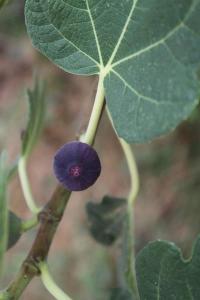 Real food foraging is taking Freetarian tactics to a whole other edible landscape. It’s not about rummaging through the grocery store’s dump site or scrapping bubblegum off the concrete. Real food foraging is a learned art: It bridges culinary knowledge, environmental awareness and plant/fungus identification to your own edible advantage. Growing up with a Greek mom means you are always fed, and digest a lot of culinary knowledge. One of the innovative skills I learned from her was how to identify food on every corner. Besides knowing where to eat the best gyros pita, I learned at a young age to identify and protect our urban edible landscapes.
Real food foraging is taking Freetarian tactics to a whole other edible landscape. It’s not about rummaging through the grocery store’s dump site or scrapping bubblegum off the concrete. Real food foraging is a learned art: It bridges culinary knowledge, environmental awareness and plant/fungus identification to your own edible advantage. Growing up with a Greek mom means you are always fed, and digest a lot of culinary knowledge. One of the innovative skills I learned from her was how to identify food on every corner. Besides knowing where to eat the best gyros pita, I learned at a young age to identify and protect our urban edible landscapes. 
From sidewalk cracks to grassy patches, my Mom taught me that pulling weeds out of the ground could lead to a tasty Vitamin K and A rich dish of boiled lemony greens. She loved that fact that we never had to buy dandelion greens from Dominick’s-we had them in our city’s backyard. We lived close to Evanston’s train tracks and Chicago’s Canal. When developers wanted to build condos there, we got involved and protested. I wasn’t aware of it at the time, but saving the small forests meant saving the trees I loved to pick mulberries from and preserving a forest floor playground of my youth.
Living in Cape Town, South Africa reveals a whole new world to me. In terms of real food urban foraging, it’s bountiful. We went to Green Renaissance’s curated talk about foraging in our City. The four speakers shared their local knowledge of each edible landscape they frolick in: Ocean, Urban, Wild, Garden, and Forest.
I’ve posted some tasty recipes in the past about Wild and Real Food Foraging with Mulberries, Grape Vine leaves, Num Nums (Natal Plum), Mushrooms, Mopane Worms, Pomegranates, Prickly Pear and Wild Olive leaves but after the talk on Thursday, I got re-inspired to explore the coastlines and forests of Cape Town’s wild and fertile city setting. 
Making Kos‘ Loubie Rusch shared her in-depth botanical knowledge including her tasty jams, jelly and cordial made from indigenious and wild foods around the city. We came home with Fennel and Wildeals as a generous gift from Bridget Kitley’s Herb Nursery to add to our growing herbal medicine cabinent: the garden. I nibbled on some sea lettuce from Julian Mori’s portable seawater aquarium and after the talk, we fried porcini and boletus in butter as a tasty snack from Gary Goldman’s mushroom escapades under the pines and poplar of Cape Town’s forests. Green Renaissance made 30 second inserts of nettle, chestnut and waterblommetjie harvests and recipes along with tips and ideas of how to forage them ourselves, along with a dried porcini gift bag for our attendance. I was a happy forager foraging the forage talk!
 The next day, I walked our dog, Lorenzo, through DeWaal park and saw the Waterberry tree was bursting with ripe fruit. Instead of them staining the concrete in their own natural graffiti style, I will be picking them next time for some Waterberry cordial on these balmy autumn afternoons.
The next day, I walked our dog, Lorenzo, through DeWaal park and saw the Waterberry tree was bursting with ripe fruit. Instead of them staining the concrete in their own natural graffiti style, I will be picking them next time for some Waterberry cordial on these balmy autumn afternoons.
So far, I am happy with Vredhoek/Gardens foraging landscape:
pomegranates, avocados, lemons, guavas, figs can be found just a short walking distance from our house.
Our own garden provides comfrey which can be used for EVERYTHING! Chris makes tea, and a great salve. Let the learning continue HERE

